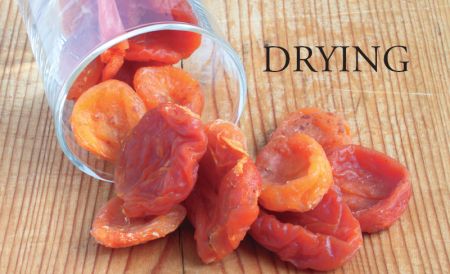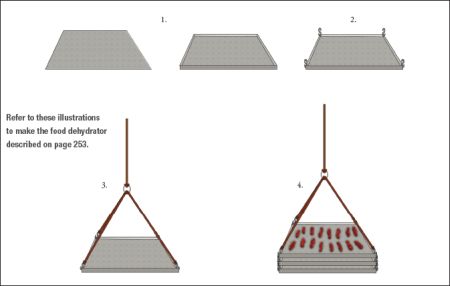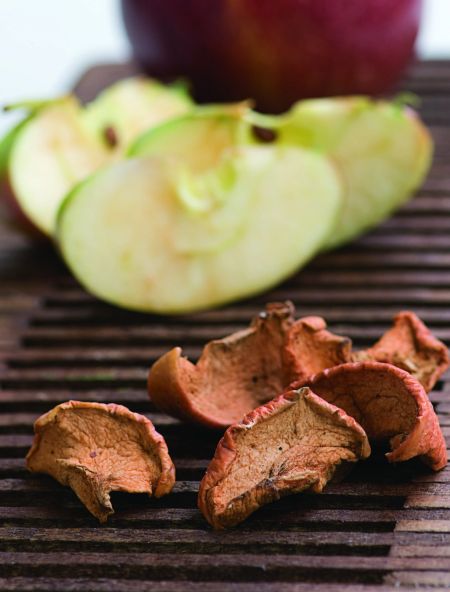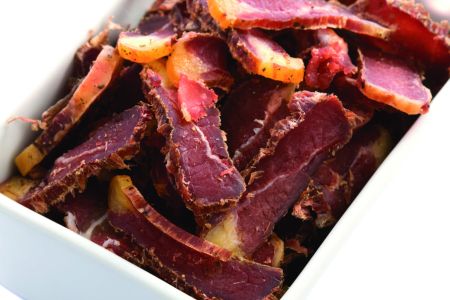
Drying fruits, vegetables, herbs, and even meat is a great way to preserve foods for longer-term storage, especially if your pantry or freezer space is limited. Dried foods take up much less space than their fresh, frozen, or canned counterparts. Drying requires relatively little preparation time, and is simple enough that kids will enjoy helping. Drying with a food dehydrator will ensure the fastest, safest, and best quality results. However, you can also dry produce in the sunshine, in your oven, or strung up over a woodstove.
For more information on food drying, check out So Easy to Preserve, 5th ed. from the Cooperative extension service, the University of Georgia. Much of the information that follows is adapted from this Excellent Source.
Drying with a Food Dehydrator
Food dehydrators use electricity to produce heat and have a fan and vents for air circulation. Dehydrators are efficiently designed to dry foods fast at around 140ºF. Look for food dehydrators in discount department stores, mailorder catalogs, the small appliance section of a department store, natural food stores, and seed or garden supply catalogs. Costs vary depending on features. Some models are expandable and additional trays can be purchased later. Twelve square feet of drying space dries about a half-bushel of produce.
Dehydrator Features to Look For
• Double-wall construction of metal or high-grade plastic. Wood is not recommended, because it is a fire hazard and is difficult to clean.
• Enclosed heating elements
• Countertop design
• An enclosed thermostat from 85 to 160ºF
• Fan or blower
• Four to ten open mesh trays made of sturdy, lightweight plastic for easy washing
• Underwriters Laboratory (UL) seal of approval
• A one-year guarantee
• Convenient service
• A dial for regulating temperature
• A timer. Often the completed drying time may occur during the night, and a timer turns the dehydrator off to prevent scorching.
Types of Dehydrators
There are two basic designs for dehydrators. One has horizontal air flow and the other has vertical air flow. In units with horizontal flow, the heating element and fan are located on the side of the unit. The major advantages of horizontal flow are: it reduces flavor mixture so several different foods can be dried at one time; all trays receive equal heat penetration; and juices or liquids do not drip down into the heating element. Vertical air flow dehydrators have the heating element and fan located at the base. If different foods are dried, flavors can mix and liquids can drip into the heating element.
Fruit Drying Procedures
Apples—Select mature, firm apples. Wash well. Pare, if desired, and core. Cut in rings or slices ⅛ to ¼ inch thick or cut in quarters or eighths. Soak in ascorbic acid, vinegar, or lemon juice for 10 minutes. Remove from solution and drain well. Arrange in single layer on trays, pit side up. Dry until soft, pliable, and leathery; there should be no moist area in center when cut.
Apricots—Select firm, fully ripe fruit. Wash well. Cut in half and remove pit. Do not peel. Soak in ascorbic acid, vinegar, or lemon juice for 10 minutes. Remove from solution and drain well. Arrange in single layer on trays, pit side up with cavity popped up to expose more flesh to the air. Dry until soft, pliable, and leathery; there should be no moist area in center when cut.
Bananas—Select firm, ripe fruit. Peel. Cut in ⅛-inch slices. Soak in ascorbic acid, vinegar, or lemon juice for 10 minutes. Remove and drain well. Arrange in single layer on trays. Dry until tough and leathery.
Berries—Select firm, ripe fruit. Wash well. Leave whole or cut in half. Dip in boiling water 30 seconds to crack skins. Arrange on drying trays not more than two berries deep. Dry until hard and berries rattle when shaken on trays.
Cherries—Select fully ripe fruit. Wash well. Remove stems and pits. Dip whole cherries in boiling water 30 seconds to crack skins. Arrange in single layer on trays. Dry until tough, leathery, and slightly sticky.
Citrus peel—Select thick-skinned oranges with no signs of mold or decay and no color added to skin. Scrub oranges well with brush under cool running water. Thinly peel outer  to ⅛ inch of the peel; avoid white bitter part. Soak in ascorbic acid, vinegar, or lemon juice for 10 minutes. Remove from solution and drain well. Arrange in single layers on trays. Dry at 130°F for 1 to 2 hours; then at 120°F until crisp.
to ⅛ inch of the peel; avoid white bitter part. Soak in ascorbic acid, vinegar, or lemon juice for 10 minutes. Remove from solution and drain well. Arrange in single layers on trays. Dry at 130°F for 1 to 2 hours; then at 120°F until crisp.
Figs—Select fully ripe fruit. Wash or clean well with damp towel. Peel dark-skinned varieties if desired. Leave whole if small or partly dried on tree; cut large figs in halves or slices. If drying whole figs, crack skins by dipping in boiling water for 30 seconds. For cut figs, soak in ascorbic acid, vinegar, or lemon juice for 10 minutes. Remove and drain well. Arrange in single layers on trays. Dry until leathery and pliable.
Grapes and black currants—Select seedless varieties. Wash, sort, and remove stems. Cut in half or leave whole. If drying whole, crack skins by dipping in boiling water for 30 seconds. If halved, dip in ascorbic acid or other antimicrobial solution for 10 minutes. Remove and drain well. Dry until pliable and leathery with no moist center.
Melons—Select mature, firm fruits that are heavy for their size; cantaloupe dries better than watermelon. Scrub outer surface well with brush under cool running water. Remove outer skin, any fibrous tissue, and seeds. Cut into ¼- to ½-inch-thick slices. Soak in ascorbic acid, vinegar, or lemon juice for 10 minutes. Remove and drain well. Arrange in single layer on trays. Dry until leathery and pliable with no pockets of moisture.
Nectarines and peaches—Select ripe, firm fruit. Wash and peel. Cut in half and remove pit. Cut in quarters or slices if desired. Soak in ascorbic acid, vinegar, or lemon juice for 10 minutes. Remove and drain well. Arrange in single layer on trays, pit side up. Turn halves over when visible juice disappears. Dry until leathery and somewhat pliable.
Pears—Select ripe, firm fruit. Bartlett variety is recommended. Wash fruit well. Pare, if desired. Cut in half lengthwise and core. Cut in quarters, eighths, or slices ⅛ to ¼ inch thick. Soak in ascorbic acid, vinegar, or lemon juice for 10 minutes. Remove and drain. Arrange in single layer on trays, pit side up. Dry until springy and suede-like with no pockets of moisture.
Plums and prunes—Wash well. Leave whole if small; cut large fruit into halves (pit removed) or slices. If left whole, crack skins in boiling water 1 to 2 minutes. If cut in half, dip in ascorbic acid or other antimicrobial solution for 10 minutes. Remove and drain. Arrange in single layer on trays, pit side up, cavity popped out. Dry until pliable and leathery; in whole prunes, pit should not slip when squeezed.
Fruit Leathers
Fruit leathers are a tasty and nutritious alternative to store-bought candies that are full of artificial sweeteners and preservatives. Blend the leftover fruit pulp from making jelly or use fresh, frozen, or drained canned fruit. Ripe or slightly overripe fruit works best.
Chances are the fruit leather will get eaten before it makes it into the cupboard, but it can keep up to one month at room temperature. For storage up to one year, place tightly wrapped rolls in the freezer.
Ingredients
2 cups fruit
2 tsp lemon juice or ⅛ tsp ascorbic acid (optional)
¼ to ½ cup sugar, corn syrup, or honey (optional)
Directions
1. Wash fresh fruit or berries in cool water. Remove peel, seeds, and stem.
2. Cut fruit into chunks. Use 2 cups of fruit for each 13 x 15-inch inch fruit leather. Purée fruit until smooth.
3. Add 2 teaspoons of lemon juice or ⅛ teaspoon ascorbic acid (375 mg) for each 2 cups light-colored fruit to prevent darkening.
4. Optional: To sweeten, add corn syrup, honey, or sugar. Corn syrup or honey is best for longer storage because these sweeteners prevent crystals. Sugar is fine for immediate use or short storage. Use ¼ to ½ cup sugar, corn syrup, or honey for each 2 cups of fruit. Avoid aspartame sweeteners as they may lose sweetness during drying.
• Applesauce can be dried alone or added to any fresh fruit purée as an extender. It decreases tartness and makes the leather smoother and more pliable.
• To dry fruit in the oven, a 13 X 15-inch cookie pan with edges works well. Line pan with plastic wrap, being careful to smooth out wrinkles. Do not use waxed paper or aluminum foil.
5. Pour the leather. Fruit leathers can be poured into a single large sheet (13 X 15 inches) or into several smaller sizes. Spread purée evenly, about ⅛ inch thick, onto drying tray. Avoid pouring purée too close to the edge of the cookie sheet.
Spices, Flavors, and Garnishes
To add interest to your fruit leathers, include spices, flavorings, or garnishes.
• Spices to try—Allspice, cinnamon, cloves, coriander, ginger, mace, mint, nutmeg, or pumpkin pie spice. Use sparingly; start with ⅛ teaspoon for each 2 cups of purée.
• Flavorings to try—Almond extract, lemon juice, lemon peel, lime juice, lime peel, orange extract, orange juice, orange peel, or vanilla extract. Use sparingly; try ⅛ to ¼ teaspoon for each 2 cups of purée.
• Delicious additions to try—Shredded coconut, chopped dates, other dried chopped fruits, granola, miniature marshmallows, chopped nuts, chopped raisins, poppy seeds, sesame seeds, or sunflower seeds.
• Fillings to try—Melted chocolate, softened cream cheese, cheese spreads, jam, preserves, marmalade, marshmallow cream, or peanut butter. Spread one or more of these on the leather after it is dried and then roll. Store in refrigerator.
6. Dry the leather. Dry fruit leathers at 140ºF. Leather dries from the outside edge toward the center. Larger fruit leathers take longer to dry. Approximate drying times are 6 to 8 hours in a dehydrator, up to 18 hours in an oven, and 1 to 2 days in the sun. Test for dryness by touching center of leather; no indentation should be evident. While warm, peel from plastic and roll, allow to cool, and rewrap the roll in plastic. Cookie cutters can be used to cut out shapes that children will enjoy. Roll, and wrap in plastic.
Vegetable Leathers
Pumpkin, mixed vegetables, and tomatoes make great leathers. Just purée cooked vegetables, strain, spread on a tray lined with plastic wrap, and dry. Spices can be added for flavoring.
Mixed Vegetable Leather
2 cups cored, cut-up tomatoes
1 small onion, chopped
¼ cup chopped celery
Salt to taste
Combine all ingredients in a covered saucepan and cook over low heat 15 to 20 minutes. Purée or force through a sieve or colander. Return to saucepan and cook until thickened. Spread on a cookie sheet or tray lined with plastic wrap. Dry at 140ºF.
Pumpkin Leather
2 cups canned pumpkin or 2 cups fresh pumpkin, cooked and puréed
½ cup honey
¼ tsp cinnamon
⅛ tsp nutmeg
⅛ tsp powdered cloves
Blend ingredients well. Spread on tray or cookie sheet lined with plastic wrap. Dry at 140ºF.
Tomato Leather
Core ripe tomatoes and cut into quarters. Cook over low heat in a covered saucepan, 15 to 20 minutes. Purée or force through a sieve or colander and pour into electric fry pan or shallow pan. Add salt to taste and cook over low heat until thickened. Spread on a cookie sheet or tray lined with plastic wrap. Dry at 140ºF.
Vine Drying
One method of drying outdoors is vine drying. To dry beans (navy, kidney, butter, great northern, lima, lentils, and soybeans) leave bean pods on the vine in the garden until the beans inside rattle. When the vines and pods are dry and shriveled, pick the beans and shell them. No pretreatment is necessary. If beans are still moist, the drying process is not complete and the beans will mold if not more thoroughly dried. If needed, drying can be completed in the sun, an oven, or a dehydrator.
How to Make a Woodstove Food Dehydrator
1. Collect pliable wire mesh or screens (available at hardware stores) and use wire cutters to trim to squares 12 to 16 inches on each side. The trays should be of the same size and shape. Bend up the edges of each square to create a half-inch lip (see illustrations on page 254).
2. Attach one S hook from the hardware store or a large paperclip to each side of each square (four clips per tray) to attach the trays together.
3. Cut four equal lengths of chain or twine that will reach from the ceiling to the level of the top tray. Use a wire or metal loop to attach the four pieces together at the top and secure to a hook in the ceiling above the woodstove. Attach the chain or twine to the hooks on the top tray.
4. To use, fill trays with food to dry, starting with the top tray. Link trays together using the S hooks or strong paperclips. When the foods are dried, remove the entire stack and disassemble. Remove the dried food and store.
Herbs
Drying is the easiest method of preserving herbs. Simply expose the leaves, flowers, or seeds to warm, dry air. Leave the herbs in a well-ventilated area until the moisture evaporates. Sun drying is not recommended because the herbs can lose flavor and color.
The best time to harvest most herbs for drying is just before the flowers first open when they are in the bursting bud stage. Gather the herbs in the early morning after the dew has evaporated to minimize wilting. Avoid bruising the leaves. They should not lie in the sun or unattended after harvesting. Rinse herbs in cool water and gently shake to remove excess moisture. Discard all bruised, soiled, or imperfect leaves and stems.
Dehydrator drying is another fast and easy way to dry high-quality herbs because temperature and air circulation can be controlled. Preheat dehydrator with the thermostat set to 95°F to 115°F. In areas with higher humidity, temperatures as high as 125°F may be needed. After rinsing under cool, running water and shaking to remove excess moisture, place the herbs in a single layer on dehydrator trays. Drying times may vary from one to four hours. Check periodically. Herbs are dry when they crumble, and stems break when bent. Check your dehydrator instruction booklet for specific details.
Less tender herbs—The more sturdy herbs, such as rosemary, sage, thyme, summer savory, and parsley, are the easiest to dry without a dehydrator. Tie them into small bundles and hang them to air dry. Air drying outdoors is often possible; however, better color and flavor retention usually results from drying indoors.
Tender-leaf herbs—Basil, oregano, tarragon, lemon balm, and the mints have a high moisture content and will mold if not dried quickly. Try hanging the tender-leaf herbs or those with seeds inside paper bags to dry. Tear or punch holes in the sides of the bag. Suspend a small bunch (large amounts will mold) of herbs in a bag and close the top with a rubber band. Place where air currents will circulate through the bag. Any leaves and seeds that fall off will be caught in the bottom of the bag.

Another method, especially nice for mint, sage, or bay leaf, is to dry the leaves separately. In areas of high humidity, it will work better than air drying whole stems. Remove the best leaves from the stems. Lay the leaves on a paper towel, without allowing leaves to touch. Cover with another towel and layer of leaves. Five layers may be dried at one time using this method. Dry in a very cool oven. The oven light of an electric range or the pilot light of a gas range furnishes enough heat for overnight drying. Leaves dry flat and retain a good color.
Microwave ovens are a fast way to dry herbs when only small quantities are to be prepared. Follow the directions that come with your microwave oven.
When the leaves are crispy, dry, and crumble easily between the fingers, they are ready to be packaged and stored. Dried leaves may be left whole and crumbled as used, or coarsely crumbled before storage. Husks can be removed from seeds by rubbing the seeds between the hands and blowing away the chaff. Place herbs in airtight containers and store in a cool, dry, dark area to protect color and fragrance.
Dried herbs are usually three to four times stronger than the fresh herbs. To substitute dried herbs in a recipe that calls for fresh herbs, use ¼ to ⅓ of the amount listed in the recipe.
Jerky
Jerky is great for hiking or camping because it supplies protein in a very lightweight form—plus it can be very tasty. A pound of meat or poultry weighs about four ounces after being made into jerky. In addition, because most of the moisture is removed, it can be stored for one to two months without refrigeration.
Jerky has been around since the ancient Egyptians began drying animal meat that was too big to eat all at once. Native Americans mixed ground dried meat with dried fruit or suet to make pemmican. Biltong is dried meat or game used in many African countries. The English word jerky came from the Spanish word charque, which means, “dried salted meat.”
Drying is the world’s oldest and most common method of food preservation. Enzymes require moisture in order to react with food. By removing the moisture, you prevent this biological action.
Jerky can be made from ground meat, which is often less expensive than strips of meat and allows you to combine different kinds of meat if desired. You can also make it into any shape you want! As with strips of meat, an internal temperature of 160ºF is necessary to eliminate disease-causing bacteria such as E. coli, if present.
Food Safety
The USDA Meat and Poultry Hotline’s current recommendation for making jerky safely is to heat meat to 160°F and poultry to 165°F before the dehydrating process. This ensures that any bacteria present are destroyed by heat. If your food dehydrator doesn’t heat up to 160°F, it’s important to cook meat slightly in the oven or by steaming before drying. After heating, maintain a constant dehydrator temperature of 130 to 140°F during the drying process.
According to the USDA, you should always:
• Wash hands thoroughly with soap and water before and after working with meat products.
• Use clean equipment and utensils.
• Keep meat and poultry refrigerated at 40°F or slightly below; use or freeze ground beef and poultry within two days, and whole red meats within three to five days.
• Defrost frozen meat in the refrigerator, not on the kitchen counter.
• Marinate meat in the refrigerator. Don’t save marinade to re-use. Marinades are used to tenderize and flavor the jerky before dehydrating it.
• If your food dehydrator doesn’t heat up to 160°F (or 165°F for poultry), steam or roast meat before dehydrating it.
• Dry meats in a food dehydrator that has an adjustable temperature dial and will maintain a temperature of at least 130 to 140°F throughout the drying process.
Preparing the Meat
1. Partially freeze meat to make slicing easier. Slice meat across the grain ⅛ to ¼ inch thick. Trim and discard all fat, gristle, and membranes or connective tissue.
2 Marinate the meat in a combination of oil, salt, spices, vinegar, lemon juice, teriyaki, soy sauce, beer, or wine.

Marinated Jerky
¼ cup soy sauce
1 tbsp Worcestershire sauce
1 tsp brown sugar
¼ tsp black pepper
½ tsp fresh ginger, finely grated
1 tsp salt
1 ½ to 2 lbs of lean meat strips (beef, pork, or venison)
1. Combine all ingredients except the strips, and blend. Add meat, stir, cover, and refrigerate at least one hour.
2. If your food dehydrator doesn’t heat up to 160°F, bring strips and marinade to a boil and cook for 5 minutes.
3. Drain meat in a colander and absorb extra moisture with clean, absorbent paper towels. Arrange strips in a single layer on dehydrator trays, or on cake racks placed on baking sheets for oven drying.
4. Place the racks in a dehydrator or oven preheated to 140ºF, or 160°F if the meat wasn’t precooked. Dry until a test piece cracks but does not break when it is bent (10 to 24 hours for samples not heated in marinade, 3 to 6 hours for preheated meat). Use paper towel to pat off any excess oil from strips, and pack in sealed jars, plastic bags, or plastic containers.
